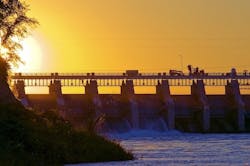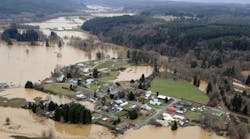South Dakota Dam Water Rises
The water in Oahe Dam, S.D., has risen to less than 3 ft from the top, into the “exclusive flood control” zone, and the U.S. Army Corps of Engineers’ flood management team based in Omaha says it will increase the release from the dam to lower the reservoir level.
According to Capital Journal, the “exclusive flood control” zone is the top few feet of the Upper Missouri River’s storage system behind each of the six mainstream dams.
With a record March runoff above Sioux City in the Upper Missouri Basin, while below South Dakota there still is effects of the flood damage of a month ago, it was not unexpected that Oahe’s top flood control space would get used to balance the downstream and upstream effects of spring runoff, according to Capital Journal.
The water was at 1617.4 ft in Lake Oahe, based on Army Corps numbers on Monday. According to Capital Journal, another report on the Army Corp's website indicated it is at 1617.2 as of April 22. The flood control zone in Oahe begins at 1617 ft and goes to 1620. That leaves 3.6 ft - or 3.8 ft - left in the top, or “exclusive flood control” zone behind the dam
According to Capital Journal, whatever is done at one dam affects the other dams, and the Army Corps balances the releases looking at long-term and short-term causes and effects. Oahe’s reservoir has been up into the “exclusive flood control” zone as recently as 2018, and nine other times, since 1975: 1984, 1986, 1995, 1996, 1997, 1999, 2010 and 2011, said Kevin Grode.
Grode is leader of the Army Corps team that manages reservoir levels out of the Omaha office.
“We are increasing releases from Oahe to lower the pool elevation [and doing the same at Fort Randall] while also trying to maintain Gavins Point releases at 55,000 [cu ft per second],” Grode told the Capital Journal.


